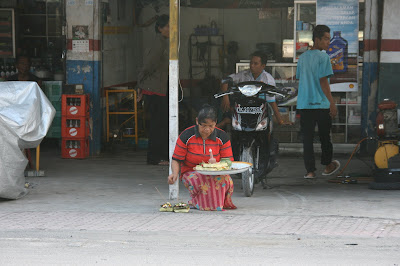



Today we drove up to Ubud, about an hour's drive north to meet Paul. He is an Australian expat who is the captain of the yacht that Tonny's been hired to design in Jakarta.
Ubud is Bali's major arts and culture center, but it has developed a large tourism industry. Soon it is going to be even larger thanks to Julia Roberts new movie, "Eat, Pray, Love" to be released this month.
On the way up we passed one of many banyan trees or beringin as they are called by the locals (first photo). The Balinese culture identifies these trees as symbols of immortality. A banyan tree can be found growing next to almost every village temple in Bali. You will find them adorned around the bottom with a black and white checkered cloth called Saput Poleng. The Black and white checked cloth symbolizes the opposing positive and negative (yin-yang) forces. Representing cosmic duality, it can be seen everywhere in Bali.
The next photo is of one of many rice fields in Bali. Farmers commonly keep ducks to act as pest control; plus their waste is good fertilizer. The next is of a village temple or Pura Desa. This is used by the villagers for honoring the deities who guard the welfare of the village.
This last photo was caught on our way home, but can be seen all over the island performed twice daily (mornings, and evenings with some exceptions). Here, this women is placing a Canang Sari. You will see these offerings in the temples, on small shrines in houses, and on the ground in front of homes and businesses. Sari, meaning essence and canang is a small square basket woven of coconut-leaves. Inside, flowers and food (such as a cracker or hardtack candy) are placed providing the sari or essence. They are presented to thank the gods in praise and prayer.